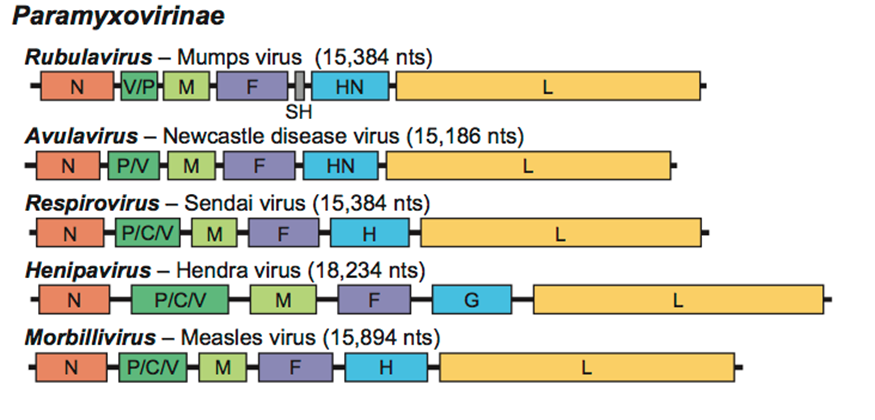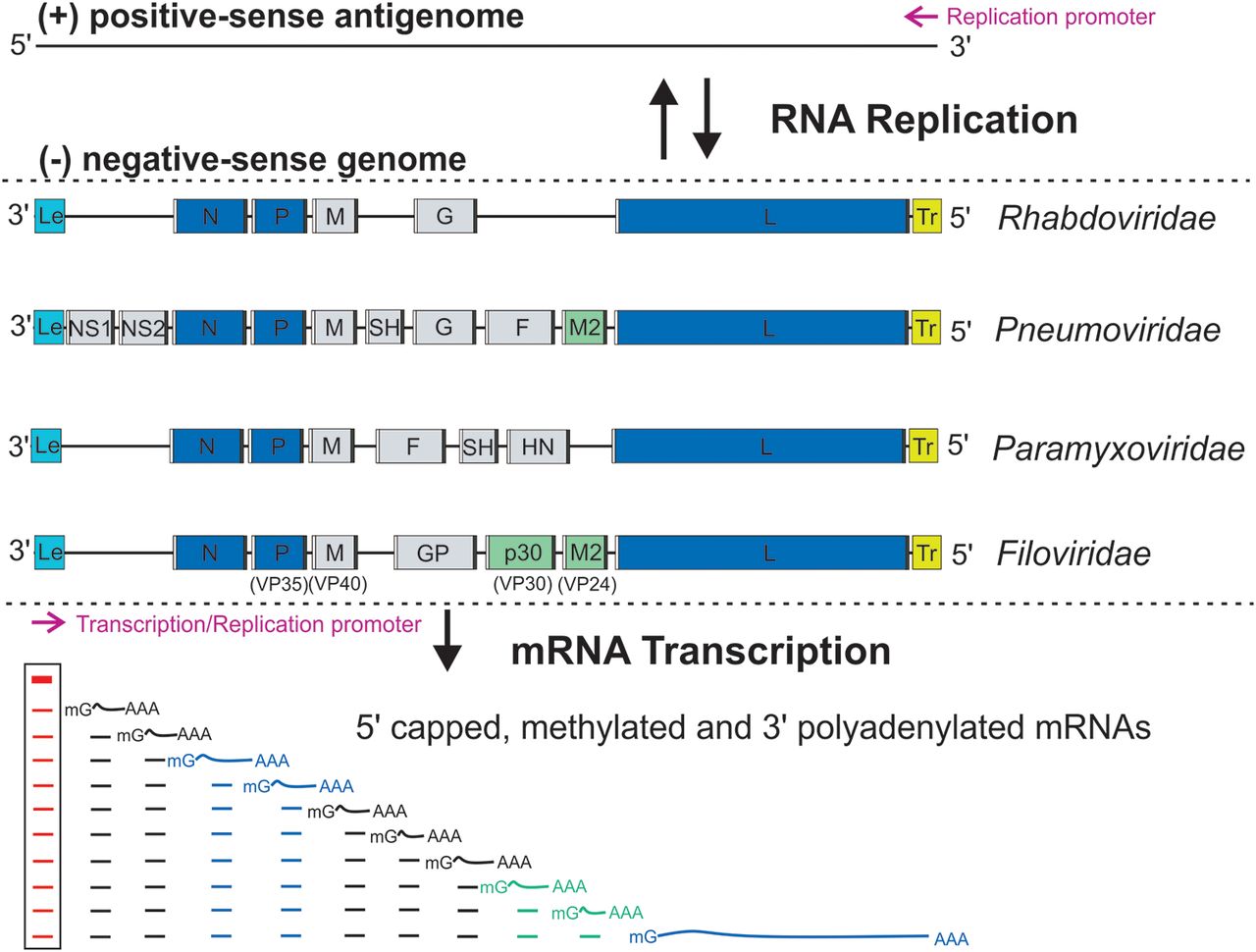|
Paramyxoviridae
''Paramyxoviridae'' (from Ancient Greek, Greek ''para-'' “by the side of” and ''myxa'' “mucus”) is a family of negative-strand RNA viruses in the order ''Mononegavirales''. Vertebrates serve as natural hosts. Diseases associated with this family include measles, mumps, and respiratory tract infections. The family has nine subfamilies that contain 23 genera. Structure Virions are enveloped and can be spherical or pleomorphic and capable of producing filamentous virions. The diameter is around 150 nm. Genomes are linear, around 15kb in length. Fusion proteins and attachment proteins appear as spikes on the virion surface. Matrix proteins inside the envelope stabilise virus structure. The nucleocapsid core is composed of the genomic RNA, nucleocapsid proteins, phosphoproteins and polymerase proteins. Genome The genome is non-segmented, negative-sense RNA, 15–19 kilobases in length, and contains six to 10 genes. Extracistronic (noncoding) regions include: * A 3’ ... [...More Info...] [...Related Items...] OR: [Wikipedia] [Google] [Baidu] |
Negative-strand RNA Virus
Negative-strand RNA viruses (−ssRNA viruses) are a group of related viruses that have Sense (molecular biology), negative-sense, single-stranded genomes made of ribonucleic acid (RNA). They have genomes that act as complementary strands from which messenger RNA (mRNA) is synthesized by the viral enzyme RNA-dependent RNA polymerase (RdRp). During replication of the viral genome, RdRp synthesizes a positive-sense antigenome that it uses as a template to create genomic negative-sense RNA. Negative-strand RNA viruses also share a number of other characteristics: most contain a viral envelope that surrounds the capsid, which encases the viral genome, −ssRNA virus genomes are usually linear, and it is common for their genome to be segmented. Negative-strand RNA viruses constitute the phylum ''Negarnaviricota'', in the kingdom ''Orthornavirae'' and realm ''Riboviria''. They are descended from a common ancestor that was a Double-stranded RNA viruses, double-stranded RNA (dsRNA) virus ... [...More Info...] [...Related Items...] OR: [Wikipedia] [Google] [Baidu] |
Rule Of Six (viruses)
The rule of six is a feature of some paramyxovirus genomes. These RNA viruses have genes made from RNA and not DNA, and their whole genome – that is the number of nucleotides – is always a multiple of six. This is because during their replication, these viruses are dependent on nucleoprotein molecules A molecule is a group of two or more atoms that are held together by attractive forces known as chemical bonds; depending on context, the term may or may not include ions that satisfy this criterion. In quantum physics, organic chemistry ... that each bind to six nucleotides.. References {{reflist Paramyxoviridae ... [...More Info...] [...Related Items...] OR: [Wikipedia] [Google] [Baidu] |
Mononegavirales
''Mononegavirales'' is an order of negative-strand RNA viruses which have nonsegmented genomes. Some members that cause human disease in this order include Ebola virus, human respiratory syncytial virus, measles virus, mumps virus, Nipah virus, and rabies virus. Important pathogens of nonhuman animals and plants are also in the group. The order includes eleven virus families: '' Artoviridae'', '' Bornaviridae'', ''Filoviridae'', '' Lispiviridae'', '' Mymonaviridae'', '' Nyamiviridae'', ''Paramyxoviridae'', '' Pneumoviridae'', ''Rhabdoviridae'', '' Sunviridae'', and '' Xinmoviridae''. Use of term The order ''Mononegavirales'' (pronounced: ) According to the rules for taxon naming established by the International Committee on Taxonomy of Viruses (ICTV), the name ''Mononegavirales'' is always to be capitalized, italicized, and never abbreviated. The names of the order's physical members ("mononegaviruses" or "mononegavirads") are to be written in lower case, are not italicized, ... [...More Info...] [...Related Items...] OR: [Wikipedia] [Google] [Baidu] |
Hemagglutinin-neuraminidase
Hemagglutinin-neuraminidase refers to a single viral protein that has both hemagglutinin and (endo) neuraminidase activity. This is in contrast to the proteins found in influenza, where both functions exist but in two separate proteins. Its neuraminidase domain has the CAZy designation glycoside hydrolase family 83 (GH83). It does show a structural similarity to influenza viral neuraminidase Viral neuraminidase is a type of neuraminidase found on the surface of influenza viruses that enables the virus to be released from the host cell. Neuraminidases are enzymes that cleave sialic acid (also called neuraminic acid) groups from ... and has a six-bladed beta-propeller structure. This Pfam entry also matches measles hemagglutinin (cd15467), which has a "dead" neuraminidase part repurposed as a receptor binding site. Hemagglutinin-neuraminidase allows the virus to stick to a potential host cell, and cut itself loose if necessary. Hemagglutinin-neuraminidase can be found ... [...More Info...] [...Related Items...] OR: [Wikipedia] [Google] [Baidu] |
Viral Entry
Viral entry is the earliest stage of infection in the viral life cycle, as the virus comes into contact with the host cell (biology), cell and introduces viral material into the cell. The major steps involved in viral entry are shown below. Despite the variation among viruses, there are several shared generalities concerning viral entry. Reducing cellular proximity How a virus enters a cell is different depending on the type of virus it is. A virus with a Viral envelope, nonenveloped capsid enters the cell by attaching to the attachment factor located on a host cell. It then enters the cell by endocytosis or by making a hole in the membrane of the host cell and inserting its viral genome. Cell entry by enveloped viruses is more complicated. Enveloped viruses enter the cell by attaching to an attachment factor located on the surface of the host cell. They then enter by endocytosis or a direct membrane fusion event. The fusion event is when the virus membrane and the host cell m ... [...More Info...] [...Related Items...] OR: [Wikipedia] [Google] [Baidu] |
Hemagglutinin
The term hemagglutinin (alternatively spelt ''haemagglutinin'', from the Greek , 'blood' + Latin , 'glue') refers to any protein that can cause red blood cells (erythrocytes) to clump together (" agglutinate") ''in vitro''. They do this by binding to the sugar residues on a red blood cell; when a single hemagglutinin molecule binds sugars from multiple red blood cells, it "glues" these cells together. As a result, they are carbohydrate-binding proteins (lectins). The ability to bind red blood cell sugars have independently appeared several times, and as a result hemaglutinins do not all bind using the same mechanism. The ability to bind red blood sugars is also not necessarily related to the ''in vivo'' function of the protein. The term ''hemagglutinin'' is most commonly applied to plant and viral lectins. Natural proteins that clump together red blood cells were known since the turn of the 19th century. Virologist George K. Hirst is also credited for "discovering agglutination a ... [...More Info...] [...Related Items...] OR: [Wikipedia] [Google] [Baidu] |
Paramyxovirus Genome Structure
Paramyxovirus can refer to two different groups of viruses: *a member of the family ''Paramyxoviridae ''Paramyxoviridae'' (from Ancient Greek, Greek ''para-'' “by the side of” and ''myxa'' “mucus”) is a family of negative-strand RNA viruses in the order ''Mononegavirales''. Vertebrates serve as natural hosts. Diseases associated with this ...'' can be called a paramyxovirus (no italics) *the genus '' Respirovirus'' was known as ''Paramyxovirus'' (with italics) until 1998 {{disambig ... [...More Info...] [...Related Items...] OR: [Wikipedia] [Google] [Baidu] |
RNA-dependent RNA Polymerase
RNA-dependent RNA polymerase (RdRp) or RNA replicase is an enzyme that catalyzes the self-replication, replication of RNA from an RNA template. Specifically, it catalyzes synthesis of the RNA strand Complementarity (molecular biology), complementary to a given RNA template. This is in contrast to typical DNA-dependent RNA polymerases, which all organisms use to catalyze the transcription (genetics), transcription of RNA from a DNA template. RdRp is an essential protein encoded in the genomes of most RNA-containing viruses that lack a DNA stage, including SARS-CoV-2. Some eukaryotes also contain RdRps, which are involved in RNA interference and differ structurally from viral RdRps. History Viral RdRps were discovered in the early 1960s from studies on mengovirus and polio virus when it was observed that these viruses were not sensitive to actinomycin D, a drug that inhibits cellular DNA-directed RNA synthesis. This lack of sensitivity suggested the action of a virus-specific ... [...More Info...] [...Related Items...] OR: [Wikipedia] [Google] [Baidu] |
Measles
Measles (probably from Middle Dutch or Middle High German ''masel(e)'', meaning "blemish, blood blister") is a highly contagious, Vaccine-preventable diseases, vaccine-preventable infectious disease caused by Measles morbillivirus, measles virus. Other names include ''morbilli'', ''rubeola'', ''9-day measles, red measles'', and ''English measles''. Symptoms usually develop 10–12 days after exposure to an infected person and last 7–10 days. Initial symptoms typically include fever, often greater than , cough, Rhinitis, runny nose, and conjunctivitis, inflamed eyes. Small white spots known as Koplik's spots, Koplik spots may form inside the mouth two or three days after the start of symptoms. A red, flat rash which usually starts on the face and then spreads to the rest of the body typically begins three to five days after the start of symptoms. Common complications include diarrhea (in 8% of cases), Otitis media, middle ear infection (7%), and pneumonia (6%). These occur i ... [...More Info...] [...Related Items...] OR: [Wikipedia] [Google] [Baidu] |
Glycoprotein
Glycoproteins are proteins which contain oligosaccharide (sugar) chains covalently attached to amino acid side-chains. The carbohydrate is attached to the protein in a cotranslational or posttranslational modification. This process is known as glycosylation. Secreted extracellular proteins are often glycosylated. In proteins that have segments extending extracellularly, the extracellular segments are also often glycosylated. Glycoproteins are also often important integral membrane proteins, where they play a role in cell–cell interactions. It is important to distinguish endoplasmic reticulum-based glycosylation of the secretory system from reversible cytosolic-nuclear glycosylation. Glycoproteins of the cytosol and nucleus can be modified through the reversible addition of a single GlcNAc residue that is considered reciprocal to phosphorylation and the functions of these are likely to be an additional regulatory mechanism that controls phosphorylation-based signalling. In ... [...More Info...] [...Related Items...] OR: [Wikipedia] [Google] [Baidu] |
Neuraminidase
Exo-α-sialidase (, sialidase, neuraminidase; systematic name acetylneuraminyl hydrolase) is a glycoside hydrolase that cleaves the glycosidic linkages of neuraminic acids: : Hydrolysis of α-(2→3)-, α-(2→6)-, α-(2→8)- glycosidic linkages of terminal sialic acid residues in oligosaccharides, glycoproteins, glycolipids, colominic acid and synthetic substrates Neuraminidase Enzyme, enzymes are a large family, found in a range of organisms. The best-known neuraminidase is the viral neuraminidase, a drug target for the prevention of the spread of influenza infection. Viral neuraminidase was the first neuraminidase to be identified. It was discovered in 1957 by Alfred Gottschalk (biochemist), Alfred Gottschalk at the WEHI, Walter and Eliza Hall Institute in Melbourne. The viral neuraminidases are frequently used as antigenic determinants found on the surface of the influenza virus. Some variants of the influenza neuraminidase confer more virulence to the virus than others. Ot ... [...More Info...] [...Related Items...] OR: [Wikipedia] [Google] [Baidu] |








